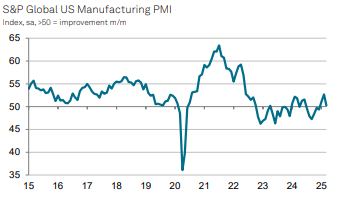Output slips, hiring stagnates, and cost pressures mount as policy uncertainty weighs on factories.
The US manufacturing sector lost steam in March, with growth stalling amid rising input costs and growing concerns over upcoming tariffs. According to the latest data from S&P Global, the seasonally adjusted Manufacturing PMI® dipped to 50.2 from 52.7 in February, marking the weakest improvement in factory conditions so far in 2025.
Though the PMI reading stayed above the neutral 50.0 level for the third month in a row, the slowdown was notable. Factory output contracted for the first time since December, ending the strong expansion seen in February. Businesses cited fading momentum from earlier tariff-related production increases and growing uncertainty around federal government policies.
Backlogs of work continued to decline, reflecting ongoing weak demand. March also marked the fastest drop in outstanding orders since December, adding to signs of a cooling manufacturing environment.
Manufacturing in the US entered a slower gear in March, as rising costs, trade policy uncertainty, and softer demand combined to weigh on business conditions. While some manufacturers saw modest export growth and signs of domestic resilience, the broader outlook remains clouded by inflationary pressures and cautious investment behavior.

Source: SP Global
Russia-Ukraine peace efforts remain stalled.
Detail Trump Pressures Fed as Dollar Slips After Cut (12.11.2025)The Federal Reserve ended 2025 with a 25-bps cut to 3.50-3.75%, maintaining guidance for one cut in 2026.
Detail Fed Day Takes Shape, Chair Decision Nears (12.10.2025)Income strategies are under pressure as lower yields reduce the appeal of short-term Treasuries, pushing investors toward riskier segments such as high yield, emerging-market debt, private credit, and catastrophe bonds.
DetailThen Join Our Telegram Channel and Subscribe Our Trading Signals Newsletter for Free!
Join Us On Telegram!